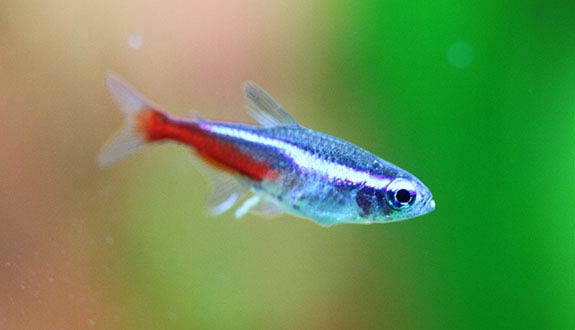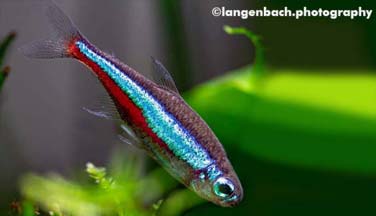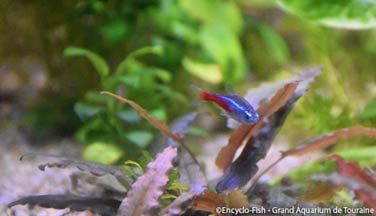

Alternative species (click on the thumbnail to see the card)
Names
Scientific name
Paracheirodon innesi
Hyphessobrycon innesi
Common name
Neon tetra
Origin

Origin: Peru, Colombia and Brazil
Biotope: Amazonian
Dimorphism

The male is slender. Its blue longitudinal line is straight unlike that of the female who is "broken"
Group

Characidae
Volume

100 L / 22 imp gal / 26 US gal
Parameters

T°: 20 to 24°C or 68 to 75°F
pH: 6.5 to 7
Hardness: 10 to 15°dGH
Difficulty

Average
Size

4 cm (1.6")
Longevity

5 years
Living zone
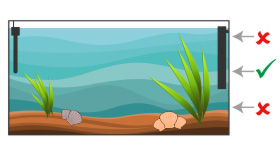
Middle
Individuals

12
Food
How to feed the Neon tetra?
Food
How to feed the Neon tetra?
Carnivorous with an insectivorous tendency, the basis of the diet will be live or frozen prey, such as bloodworms, mosquito larvae, Artemia or Daphnia. It will nevertheless accept all types of food.
To keep their weight in shape, you can make them fast once a week.
Behavior
What kind of behavior does the Neon tetra have?
Behavior
What kind of behavior does the Neon tetra have?
Neons are not really shy. They swim calmly in the aquarium, dispersing and regrouping according to whether they feel safe or threatened.
They are very peaceful.
Like all species of the genus, they have a developed gregarious instinct and must live in a shoal. It is only from 20 individuals that the shoal will reveal its entire splendor.
You will be able to observe the individuals isolate themselves in couple, the males make the court with the females. Dominants will lead the shoal.
Cohabitation
Who can live with the Neon tetra?
Cohabitation
Who can live with the Neon tetra?
It is an ideal fish for a community aquarium. It is very peaceful and will not be interested in its roommates.
Quiet and discreet, you can keep it with more territorial fish like cichlids, it will not disturb them. However, you have to consider its needs. For example, it should not be associated with Guppy or Platys because the water requirements are not the same at all (acidic and soft for the Neon against basic and hard).
You can make them cohabit with other Characidae such as Tetras, dwarf cichlids (Ramirezi or Cacatuoides), Corydoras or Ancistrus. Only at adult height, they can also live with Discus and Scalar. For this kind of cohabitation, it is recommended to introduce very young Scalars with the shoal. So when they grow up, they will not take care of little Neons.
Beware of predation of large fish (more than 15 cm or 6 inches).
Also note that the smaller shrimp will be eaten.
Breeding
How to breed the Neon tetra?
Breeding
How to breed the Neon tetra?
Even if its breeding is possible, it remains rather difficult.
Place in a spawning tank (20 L / 4 imp gal / 5 US gal) equipped with a protective grid and thin-leaved plants (so that the fish can deposit their eggs), a male and a female. Lightly lit tank, temperature 24°C or 75°F, pH 6, filtered on peat.
Separate male and female (using a splitter plate in the aquarium for example) 15 days before spawning and feed them with live prey. Keep them in FRESHWATER 19/21°C or 66/70°F. Then, introduce a couple in the laying aquarium in the evening, spawning will normally take place the next morning. A laying can go up to 300 eggs and the incubation lasts 24 hours.
Remove the parents as soon as the eggs appear. Fry are afraid of light and must grow in total darkness.
Food fry: infusoria, artemia nauplies and cyclops.
Its aquarium
Which aquarium for the Neon tetra?
Its aquarium
Which aquarium for the Neon tetra?
This species requires good quality water (no nitrites and the lowest nitrate possible, no chemical supplement). Too hot water will be fatal in the long run.
You can build your aquarium with lush vegetation and peat bog roots. However, it will reveal its maximum beauty in Amazonian biotope aquariums. Typically, a river sand substrate will be ideal and the scenery will be organized around some twisted branches or driftwood. For a natural effect, add a litter of dried oak or beech leaves. It will be necessary to renew these sheets regularly so as not to rot. These leaves, which slightly colour water, are an excellent bacterial carrier and their decomposition releases a chemistry considered beneficial to the aquarium. Finally, as for all aquariums in the Amazon biotope, the lighting is quite weak (dim the lighting with floating plants). Choose your plants accordingly (Microsorum, Taxiphyllum or Cryptocoryne for example).
Good To know
Find all additional information!
Good To know
Find all additional information!
This species is to be reserved for aquarists who already have some experience because of its fragile health and its requirement on the quality of its water.
Neon Tetra is one of the most common species in aquariums, although it is not suitable for all aquariums. Because of this success, the years of commercial breeding have somewhat undermined its robustness. As a result, the strains sold are regularly prone to morphological defects and are more susceptible to disease. For example, it is a rather fragile species concerning its heart. It is therefore necessary to be very careful with its acclimation, and to avoid any intense stress because it can have a heart attack. This will also prevent the appearance of the famous white spot disease. Neon Tetra also suffers from a specific disease caused by a protozoan: Neon disease, which is often fatal. In this case, quarantine the diseased fish for treatment.
Did you know that this Neon could change colour? Indeed, its colours darken at night which makes it almost invisible. You will also notice that its colours fade in case of stress.
There are varieties albino, golden, veiled, more rarely available in store.
Paracheirodon innesi Black diamond
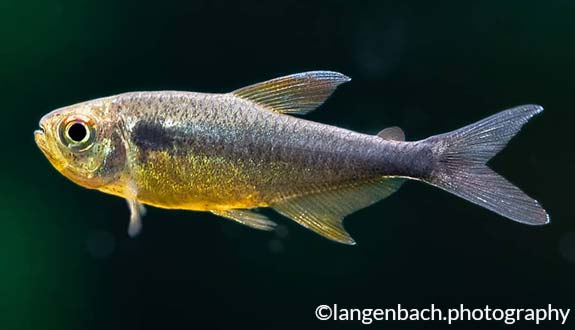
Paracheirodon innesi Gold
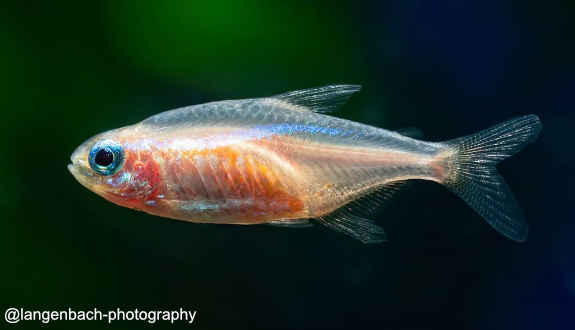
Yours photos!

By Encyclo-Caro
Comments
Sort by:
Please login to post comments
